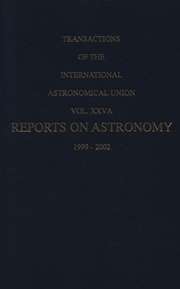No CrossRef data available.
Article contents
25. The Secondary Maximum of T Coronae Borealis
Published online by Cambridge University Press: 02 August 2017
Extract
T Coronae Borealis is a well-known recurrent nova which has undergone two outbursts: in 1886 and in 1946. In both cases the star declined very fast after maximum and reach in less than two months the premaximum magnitude, shortly afterwards, there a small increase to a secondary very flat maximum followed by a slower decrease.
The symbiotic spectrum observed at minimum is usually interpreted as due to a binary involved in a small nebula; the excitation of the nebular spectrum is provided by shot fainter star, which undergoes the nova outbursts, while the brighter star (a normal ant) is constant in brightness. Sanford(1) has found the radial velocity of the M star 2 variable with a period of 774 days and a semi-amplitude of 21 km./sec.
- Type
- Part IV Symposia
- Information
- Copyright
- Copyright © Cambridge University Press 1954


